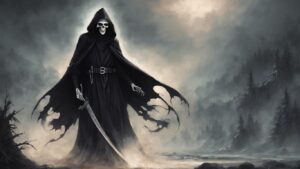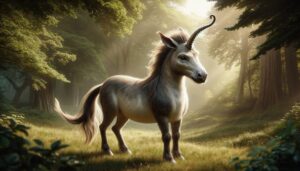Table of Contents
In the shadowy realm of mythical creatures, one figure stands as a chilling enigma, shrouded in whispers and legend: the Goatman. A creature that straddles the line between human and beast, the Goatman has captured the imagination of storytellers and fear-seekers for generations. In this extensive exploration, we will delve into the depths of the Goatman’s origins, family ties, appearance, abilities, the symbols representing it, and the myriad myths and stories that have surrounded this elusive being.
Origins
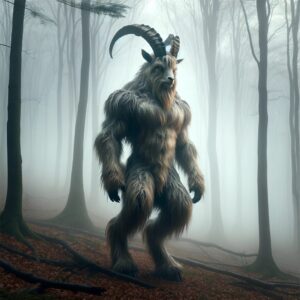
The origins of the Goatman are steeped in mystery, with various interpretations and regional variations. One common thread is the creature’s hybrid nature, embodying both human and goat-like characteristics. Some legends suggest that the Goatman was once a human, who through dark rituals or a curse, transformed into this grotesque form. Others believe it to be a product of a forbidden union between a human and a goat.
Family-wise, the Goatman is often portrayed as a solitary being, lurking in the depths of forests, swamps, or remote rural areas. Rarely does it exhibit familial bonds, further adding to its eerie and elusive nature.
Appearance
The Goatman’s appearance varies depending on the source and regional folklore, but certain elements remain consistent. Standing at an imposing height, the Goatman boasts a humanoid upper body, complete with arms, torso, and a grotesque human-like head. Its lower half, however, takes on the form of a goat, complete with cloven hooves and shaggy fur.
Its face is a twisted mockery of humanity, often featuring menacingly sharp teeth and malevolent, glowing eyes that peer out from beneath matted, unkempt hair. Some accounts even describe the Goatman as having multiple eyes, further enhancing its otherworldly and terrifying visage.
Abilities
The Goatman is not merely a grotesque form; it possesses a range of abilities that make it a formidable and elusive presence in the mythical world. In addition to its grotesque appearance, one of its most iconic traits is its agility and speed, which it uses to stalk its prey through dense forests or isolated rural areas. Moreover, its keen senses allow it to detect even the faintest sounds or scents, making it a masterful hunter.
Additionally, stories attribute a hypnotic power to the creature when it encounters individuals. Some tales recount how those who lock eyes with the Goatman become entranced, falling under its control, and are powerless to resist its malevolent influence.
Furthermore, the Goatman frequently garners associations with dark magic and shape-shifting abilities. This enables it to assume various forms, deceiving and terrorizing its victims. Its shape-shifting prowess intensifies the prevailing uncertainty and fear surrounding this elusive creature.
Symbology
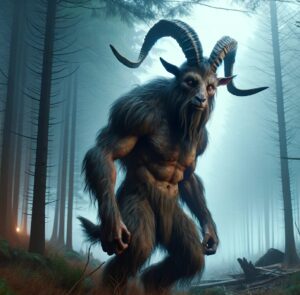
Myths and Stories
The Goatman has left an indelible mark on the collective imagination, with numerous myths and stories weaving its chilling presence into folklore across different cultures and regions.
The Maryland Goatman
One of the most famous Goatman legends originates from Maryland, USA. According to local lore, Dr. Stephen Fletcher, a scientist, conducted gruesome experiments on goats, ultimately leading to his transformation into the monstrous Goatman. This terrifying creature is said to haunt a notorious location known as Goatman’s Bridge.
Located in Prince George’s County, Maryland, Goatman’s Bridge has become a magnet for curious thrill-seekers and paranormal investigators. Moreover, the bridge spans across a dark and remote stretch of road, surrounded by dense woods that seem to hide untold secrets. In this eerie setting, reality and myth blur into a chilling fusion.
Dr. Fletcher’s descent into madness and his bizarre experiments with goats are at the heart of the Goatman legend in this area. It’s said that he was driven by a twisted desire for power and knowledge. As a result, he embarked on a path that led him to perform horrifying and forbidden rituals on innocent goats. However, these experiments took a dark turn, blurring the line between science and sorcery until it became indistinguishable.
As a result of these malevolent experiments, Dr. Fletcher’s transformation into the Goatman was inevitable. His humanity twisted and warped, he became a creature of the night, part-human and part-goat, forever trapped in a monstrous form. His haunting presence, marked by eerie cries and unsettling encounters, has made Goatman’s Bridge an eerie and unsettling destination for those who dare to venture there.
Intriguingly, tales of the Goatman’s Bridge continue to circulate, with visitors reporting eerie encounters, strange phenomena, and an overwhelming feeling of being watched. It stands as a testament to the enduring power of folklore and the capacity of legends like the Goatman to both terrify and captivate those who seek to explore the unknown.
The Popelick Monster
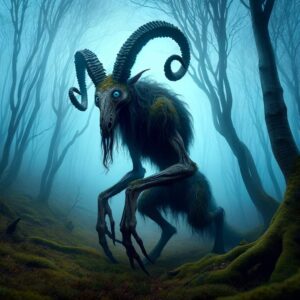
In Kentucky, a unique variant of the Goatman legend emerges as the. Believed to have originated from the tragic tale of a hermit who withdrew from society following a disfiguring accident, this chilling creature ultimately underwent a horrifying transformation into a goat-like being. The eerie stories of the Popelick Monster continue to evoke fear and unease among those who dare to venture into its purported territory.
According to local lore, the Popelick Monster’s story begins with a reclusive hermit named Old Man Popelick. He was known to dwell in the secluded forests of Kentucky, far from prying eyes and the trappings of modern civilization. Then, one fateful day, a dreadful accident befell him, resulting in life-altering disfigurements that left him an outcast from society. Consequently, his isolation grew deeper, and his appearance became increasingly grotesque.
As the years passed, the hermit’s solitude and anguish manifested in a sinister way. He delved into dark and forbidden practices, harnessing occult knowledge and mystical rituals to seek vengeance against those who had shunned him. These malevolent incantations, however, took a horrific toll on Old Man Popelick, causing his body to transform into a nightmarish fusion of human and goat.
Describing the Popelick Monster reveals a horrifying amalgamation of a humanoid upper body and a goat’s lower half, bearing a grotesque countenance that terrifies all who encounter it. Moreover, its menacing visage gains potency from a malevolent glare and sharp, glistening teeth, serving as a haunting reminder of its tragic descent into darkness.
Tales of the Popelick Monster, on the other hand, serve as a cautionary tale about the consequences of isolation and the pursuit of vengeance. Its terrifying presence continues to linger in the shadows of Kentucky’s wilderness, beckoning brave souls to test their courage in its eerie domain.
Indigenous Mythology
Across Indigenous American tribes, distinct versions of the Goatman legend emerge. Furthermore, each of these variations is intricately woven into the tapestry of their respective cultures. These narratives often depict the Goatman as an embodiment of forest spirits or trickster entities. This, in turn, reflects a profound reverence for the natural world and the enigmatic wilderness that surrounds them. In these captivating stories, the Goatman takes on a role beyond mere malevolence. Instead, it becomes a cautionary figure, a guardian of the untamed woods, and a symbol of the interconnectedness between humans and nature.
For many Indigenous tribes, the Goatman serves as a reminder of the delicate balance that exists within the wilderness. It embodies the mysteries and unseen forces that dwell within the forest, encouraging people to approach nature with respect and humility. The stories emphasize the importance of understanding the rhythms of the natural world and the need to coexist harmoniously with it.
These narratives also reflect the tribes’ deep-rooted traditions of oral storytelling, passing down wisdom from one generation to the next. They serve not only to instill a healthy fear of the wilderness but also to teach valuable lessons about survival, respect for wildlife, and the interconnectedness of all living beings. In the rich tapestry of Indigenous American folklore, the Goatman’s presence resonates as a guardian and a guide, offering a profound connection to the mysteries of the untamed woods.
The Goatman’s Lure
Across various accounts and stories, the Goatman’s modus operandi often involves luring unsuspecting victims into its domain through eerie sounds or cries, mimicking human voices or distress calls. Once ensnared, its malevolent intentions become clear, leading to fear, chaos, and in some tales, even death.
Similarities
Several mythical creatures share similarities with the Goatman in terms of their hybrid nature, menacing appearance, and eerie characteristics. Here are a few examples:
Wendigo: The Wendigo is a creature from Algonquian folklore, often described as a cannibalistic, emaciated being with a heart of ice. It embodies hunger, cold, and the dangers of the wilderness, much like the Goatman.
Satyr: In Greek mythology, Satyrs are half-human, half-goat creatures known for their mischievous and hedonistic behavior. They share the Goatman’s hybrid form but are generally less malevolent.
Minotaur: The Minotaur, from Greek mythology, is a creature with the body of a human and the head of a bull. While not goat-like, it represents the blending of human and animal characteristics.
Fleshgait: A cryptid creature in modern folklore, the Fleshgait is similar to the Goatman in its ability to mimic human voices and appearance. It’s known for its deceptive and malevolent nature.
Jersey Devil: The Jersey Devil, a creature from American folklore, has a combination of animal and human features, with a goat-like head, bat-like wings, and hooves. Eerie encounters in the Pine Barrens of New Jersey are associated with it.
Centaur: In Greek mythology, Centaurs are beings with the upper body of a human and the lower body of a horse. Like the Goatman, they represent a fusion of human and animal attributes.
Chupacabra: Latin American folklore originated the Chupacabra, a creature often described as having both reptilian and mammalian features. It has gained notoriety for its bloodsucking tendencies and its elusive nature.
Mothman: The Mothman, known for its eerie appearances and association with ominous events, is not a hybrid like the Goatman. It has human-like eyes and wings, making it a unique and unsettling entity.
FAQ
Where does the Goatman legend come from?
The legend of the Goatman is popular in various parts of the United States, particularly in rural areas and forests.
Is the Goatman dangerous?
In folklore, the Goatman is often portrayed as a menacing figure, but it's purely a myth, so it's not real or dangerous.
What abilities does the Goatman have?
In stories, the Goatman is known for its agility, speed, and keen senses, which it uses to stalk prey.
Why is it called the Goatman?
It's called the Goatman due to its goat-like features, including the head and hooves.
Are there any real sightings of the Goatman?
There are no credible, verified sightings of the Goatman; it remains a part of folklore and urban legends.


